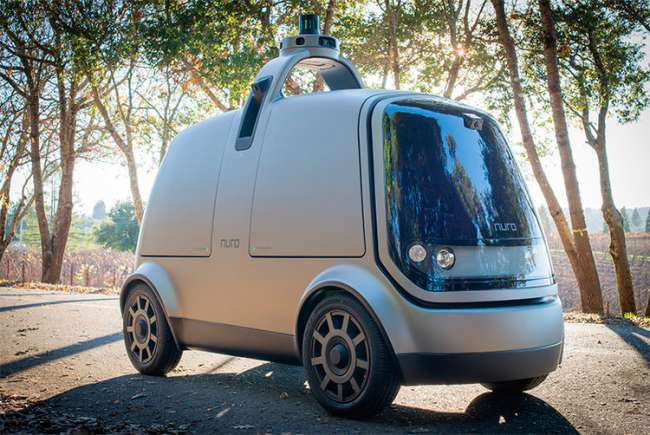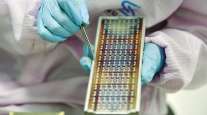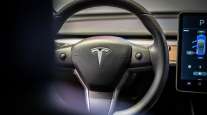Driverless Delivery Startup Uses $92 Million to Focus on Safety

In an abandoned lot on the outskirts of Sacramento, Calif., R1, a domed gray vehicle half the size of a Toyota Corolla, is practicing driving itself. It stops at stop signs, yields to people, and handles sharp turns, as other self-driving vehicles do on test courses in Silicon Valley, Detroit, and China.
But R1, made by a startup called Nuro, doesn’t need to be as good. It can make a jolting brake if it sees something on the road or cruise untroubled over a small bump — wrinkles that companies building autonomous taxis work tirelessly to remove. Nuro spent less time on this, because its robots aren’t designed to ferry people. “A lot of those problems can be solved when you remove the passenger,” says co-founder Dave Ferguson. “The pizza doesn’t care if you’re going a little slower.”
RELATED: The robot delivery vans are here
Almost every company making self-driving cars, including Alphabet’s Waymo, General Motors, and Ford Motor, says the second move will be delivery vehicles. Nuro, whose co-founders spent years on Waymo’s car project when it was still part of Google, is focused on delivery first. Without passengers, an R1 doesn’t need to worry about saving riders, so it can swerve out of the way to avoid a person, even if that’s more dangerous for the bot. Worst case, in a collision, Ferguson says, several inches of compressible foam covering the rounded front bumper will soften the impact. While R1 maxes out at 25 mph, Nuro says it expects that top speed to climb.

In our debut episode of RoadSigns, we ask: What does the move toward autonomy mean for the truck driver? Hear a snippet from Alex Rodrigues, CEO of Embark, above, and get the full program by going to RoadSigns.TTNews.com.
Even at about 74 inches tall and 1,500 pounds, the electric vehicle looks a bit like a massive toaster on wheels, with two doors carved into a monochrome frame that resembles stainless steel. “It could be worse,” Ferguson says. An Audi AG exec once panned Google’s early driverless car as an “ugly potato.” A small central console holds a camera that can spot someone approaching. Seven more cameras line the top of the robot, which is also packed with radars and lidars.
For the demo, co-founder Jiajun Zhu opens an app and makes a delivery request, placing a digital pin on his location as though he’s ordering an Uber. R1 makes its way toward him, stopping right at the curb; when Zhu taps a button on the app, two doors flip up to reveal compartments for pizza, packaged food, and whatever else the co-founders think you might want a robot to bring you. It carries 12 grocery bags; Nuro says the next version, planned for commercial release later this year, will hold 20. The company is in talks with restaurants and retailers to provide delivery services, but it wouldn’t name any.
RELATED: Delivery without drivers: Domino’s, Ford team up for test
Ferguson and Zhu have remained fairly quiet since leaving Google in 2016. They hired Russell Smith, who, like Zhu, was among the early members of Google’s self-driving effort. Early on they talked about making a home robot, but they’ve set that idea aside for now. “We might still,” Ferguson says. While at Google, he and Zhu helped set off a multibillion-dollar corporate race to make self-driving cars, one that Waymo still leads.
They’ll have to outpace a competing robot from Alibaba Group Holding Ltd. and an expected rival service from Amazon.com Inc. It’s a no-brainer to back some of the select few who’ve built self-driving cars before, says Reid Hoffman, a partner at venture firm Greylock. His company led a $92 million financing round for Nuro, which now has more than 100 employees.
Without human labor costs, Nuro’s robot has a better chance to make on-demand delivery profitable than the string of failed startups that have littered Silicon Valley in recent years, says Arun Sundararajan, a business professor at New York University who specializes in the economics of digital goods and networks.
RELATED: Pizza Hut working with Toyota to test driverless pizza delivery
But it will take a little getting used to, he says, for consumers.
Nuro’s co-founders acknowledge that they’ve had to learn some lessons in that regard. In field tests they’ve experimented with asking users to upload a faceprint so the vehicle’s facial-recognition software could open the delivery doors. “That one I thought would be the coolest — sort of this magical situation where you walk up and it opens,” Ferguson says, but he tabled the feature. “Turns out, people were much less comfortable with that.”
The company also built its robots to pull up to curbs and driveways, a feature suited for leafy suburbs. It’s harder to imagine the vehicles navigating street traffic in the cities where early adopters tend to congregate — and where tipsy jerks may try to tackle the drones in search of pizza. Nuro says the novelty of robo-delivery will wear off soon, so it’s debating antijerk countermeasures. “I’m sure,” Ferguson says, “in the early days, there will be some challenges.”




